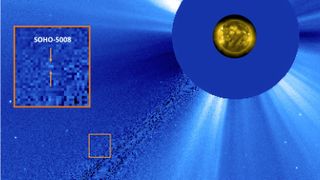Throughout the first half of October, a super bright comet, known as Tsuchinshan–ATLAS, will be visible to the naked eye in parts of the late night and early morning sky as it makes its closest approach to Earth for more than 80,000 years.
However, it turns out that the “once-in-a-lifetime” comet is not the only visitor in town. Astronomers have just discovered a second comet, C/2024 S1 (ATLAS), which will also make its closest approach to our planet this month and potentially be visible without a telescope.
Over the last few weeks, skywatchers have been obsessed with Tsuchinshan–ATLAS, which was first discovered in early 2023. The comet was previously predicted to break apart on its approach to Earth but has stayed intact and will make its closest approach to our planet on Saturday (Oct. 12). It can be spotted with the naked eye and has been captured in several stunning photographs but will likely start to fade from view in the coming weeks.
But on Sept. 27, astronomers at Hawaii’s Asteroid Terrestrial-impact Last Alert System (ATLAS) project, which played a role in discovering Tsuchinshan–ATLAS, spotted C/2024 S1 for the first time. The newfound comet was initially designated “A11bP7I” but after follow-up observations confirmed its existence, it was given its official new title, according to the Virtual Telescope Project.
Related: Blazing comet tail is whipped by solar winds in astonishing astronomy photo
Not much is known about the C/2024 S1’s size, shape or orbit around the sun. However, it likely comes from the Oort Cloud — a large reservoir of comets and other icy objects near the solar system’s edge — and probably hasn’t been this close to the sun for centuries.
The newfound comet will make its closest approach to Earth on Oct. 24, when it will come within 81.8 million miles (131.6 million km) of our planet. Four days later, on Oct. 28, it will reach its closest point to the sun, or perihelion, when it will skim past our home star at a distance of around 765,000 miles (1.2 million km).
C/2024 S1 is what astronomers call a “sungrazer” comet because it will get extremely close to our home star. If it survives its close shave with the sun, the comet will be catapulted back out toward the outer solar system. However, the odds of the comet surviving this superheated slingshot are uncertain.
On April 8, astronomers spotted another sungazing comet making its final approach to the sun on the same day as the total solar eclipse, which cast a shadow over large parts of North America. However, it disintegrated just a few hours later.

Initial photos of C/2024 S1 also hint that it has a green glow, which is a rare color for comets, Spaceweather.com reported. This unusual hue, similar to the “devil comet” (12P/Pons-Brooks) that passed close by our planet in March, comes from dicarbon molecules — two carbon molecules bonded together — in the comet’s coma and tail.
How to see C/2024 S1
At its peak brightness, between Oct. 24 and Oct. 28, the comet will be brighter than Venus and most other objects in the night sky, Forbes reported. However, it will only really be visible just before sunrise in the Southern Hemisphere.
C/2024 S1 could still be visible from the Northern Hemisphere between Oct. 29 and Oct. 31, when it will be significantly dimmer, according to Forbes. But only if it survives its slingshot around the sun.
If the comet does last long enough for you to see it, you can track the comet’s journey using TheSkyLive.com. You can also increase your chances of seeing C/2024 S1 using a good pair of stargazing binoculars or a small telescope to enhance the view.















